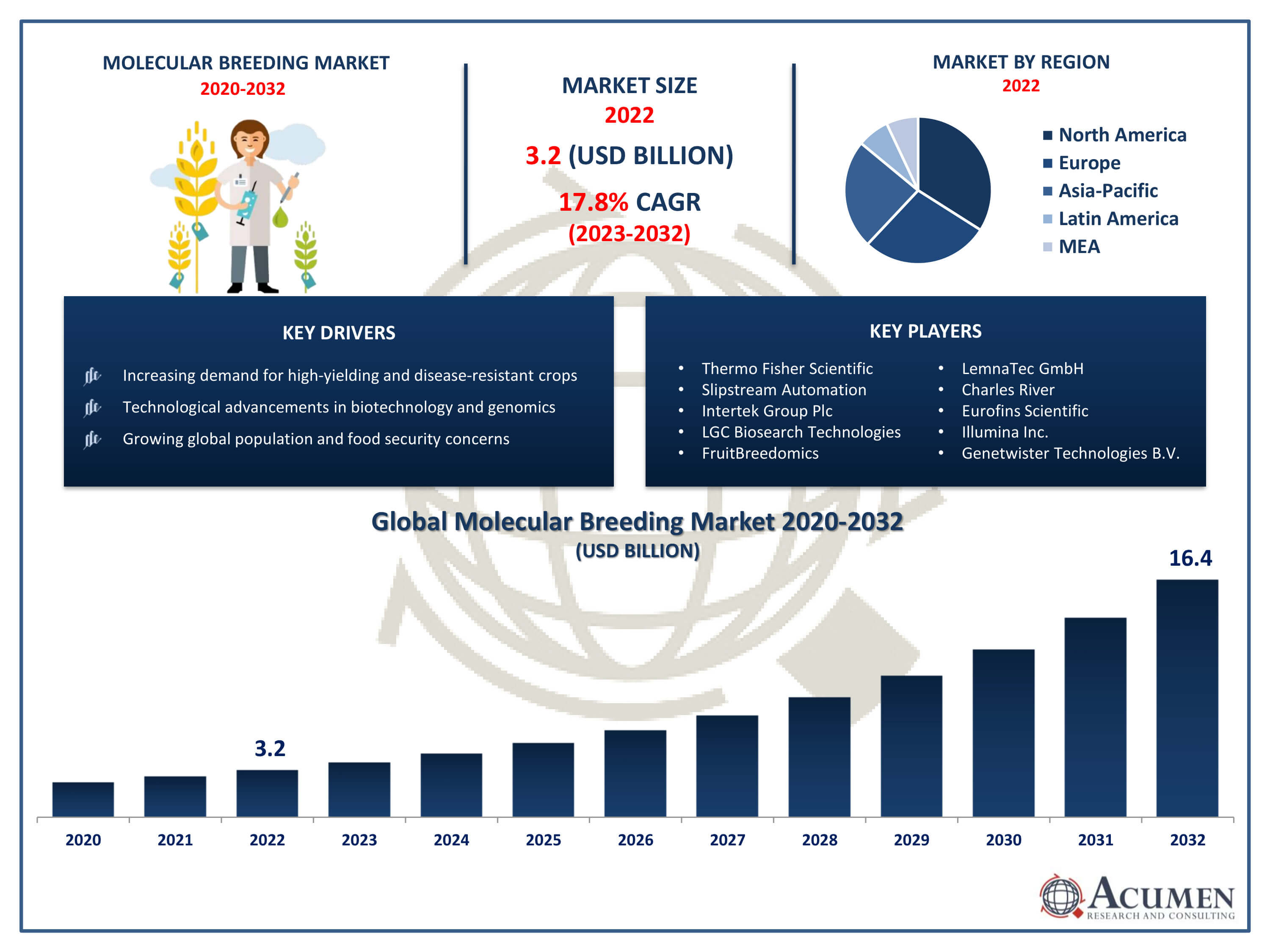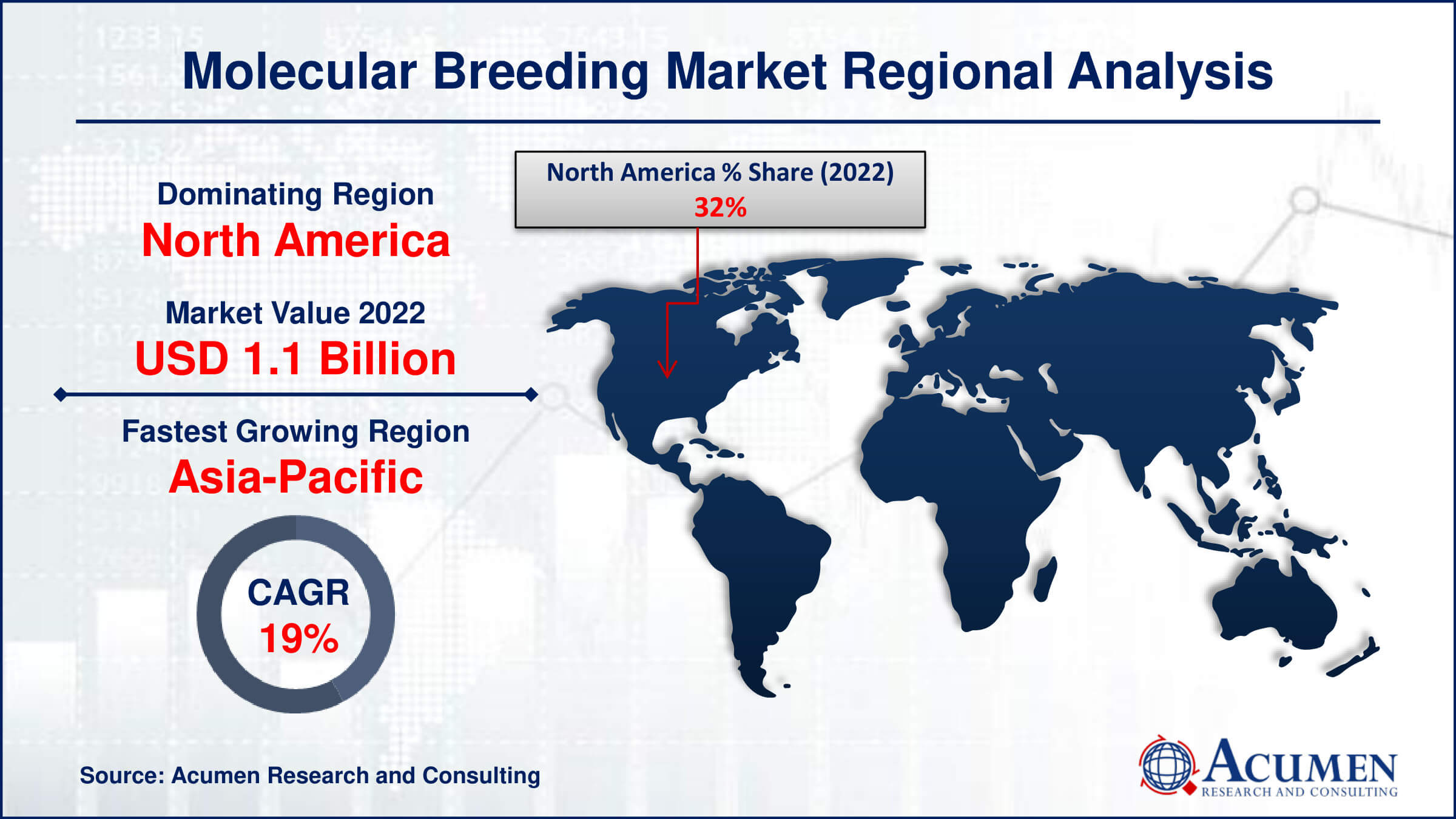April 2023
Molecular Breeding Market Size accounted for USD 3.2 Billion in 2022 and is projected to achieve a market size of USD 16.4 Billion by 2032 growing at a CAGR of 17.8% from 2023 to 2032.
The Global Molecular Breeding Market Size accounted for USD 3.2 Billion in 2022 and is projected to achieve a market size of USD 16.4 Billion by 2032 growing at a CAGR of 17.8% from 2023 to 2032.
Molecular Breeding Market Highlights

Molecular breeding, also known as molecular-assisted breeding or marker-assisted selection, is a method used in plant and animal breeding to accelerate the process of developing new varieties with desirable traits. Traditional breeding methods rely on phenotypic characteristics, which can be time-consuming and labor-intensive. Molecular breeding, on the other hand, involves the use of molecular markers linked to specific genes associated with desired traits, allowing breeders to select plants or animals with desired traits more efficiently. This targeted approach can lead to the development of improved varieties with traits such as disease resistance, higher yield, and enhanced nutritional content.
The market for molecular breeding has been experiencing significant growth in recent years due to advancements in biotechnology and increased demand for sustainable and high-yielding crops and livestock. The ability of molecular breeding to speed up the breeding process and produce more resilient and productive varieties has attracted the attention of agricultural companies, research institutions, and farmers alike. Additionally, the growing global population and the need to produce more food with limited resources have further fueled the adoption of molecular breeding technologies. As a result, the market for molecular breeding is expected to continue expanding as new technologies and methodologies are developed to further improve breeding efficiency and the quality of agricultural products.
Global Molecular Breeding Market Trends
Market Drivers
Market Restraints
Market Opportunities
Molecular Breeding Market Report Coverage
| Market | Molecular Breeding Market |
| Molecular Breeding Market Size 2022 | USD 3.2 Billion |
| Molecular Breeding Market Forecast 2032 |
USD 16.4 Billion |
| Molecular Breeding Market CAGR During 2023 - 2032 | 17.8% |
| Molecular Breeding Market Analysis Period | 2020 - 2032 |
| Molecular Breeding Market Base Year |
2022 |
| Molecular Breeding Market Forecast Data | 2023 - 2032 |
| Segments Covered | By Process, By Marker, By Application, And By Geography |
| Regional Scope | North America, Europe, Asia Pacific, Latin America, and Middle East & Africa |
| Key Companies Profiled | Thermo Fisher Scientific, Slipstream Automation, Intertek Group Plc, LGC Biosearch Technologies, FruitBreedomics, LemnaTec GmbH, Charles River, Eurofins Scientific, Illumina Inc., DanBred, Genetwister Technologies B.V., and Keygene N.V. |
| Report Coverage |
Market Trends, Drivers, Restraints, Competitive Analysis, Player Profiling, Covid-19 Analysis, Regulation Analysis |
Molecular breeding is a sophisticated approach to traditional breeding methods, leveraging molecular biology techniques to enhance the precision and efficiency of breeding programs. It involves the identification and utilization of specific genetic markers associated with desirable traits, such as disease resistance, drought tolerance, and improved nutritional content. By analyzing the DNA sequences of plants or animals, breeders can pinpoint genes that contribute to these traits and selectively breed individuals with the desired genetic makeup. This targeted approach accelerates the breeding process, allowing for the development of improved varieties in a shorter timeframe compared to conventional methods. The applications of molecular breeding span across various sectors of agriculture, including crop cultivation, livestock production, and aquaculture. In crop breeding, molecular techniques are employed to develop cultivars with increased yield potential, resistance to pests and diseases, and tolerance to abiotic stresses such as heat, drought, and salinity.
The molecular breeding market has been experiencing robust growth driven by advancements in biotechnology, increased demand for high-yielding and resilient crops, and rising concerns over food security. The adoption of molecular breeding techniques, such as marker-assisted selection and genomic selection, has enabled breeders to accelerate the development of new plant varieties with desirable traits, including disease resistance, tolerance to environmental stressors, and improved nutritional content. This targeted approach allows for a more precise selection of individuals with desired genetic characteristics, ultimately leading to the production of superior crop varieties. Furthermore, the growing global population, coupled with shrinking arable land and changing climatic conditions, has amplified the need for innovative agricultural solutions. Molecular breeding offers a promising avenue to address these challenges by enhancing the efficiency and effectiveness of breeding programs.
Molecular Breeding Market Segmentation
The global molecular breeding market segmentation is based on process, marker, application, and geography.
Molecular Breeding Market By Process
According to the molecular breeding industry analysis, the marker-assisted selection (MAS) segment accounted for the largest market share in 2022. MAS involves the use of molecular markers linked to specific genes associated with desirable traits, allowing breeders to identify and select individuals with desired genetic characteristics more efficiently. This targeted approach minimizes the need for labor-intensive and time-consuming phenotypic evaluations, thereby accelerating the development of improved varieties with traits such as disease resistance, high yield, and nutritional quality. One of the key drivers contributing to the growth of the MAS segment is the increasing demand for crops and livestock with enhanced traits to address global challenges such as food security, climate change, and resource scarcity. As the world's population continues to grow, there is a growing need to produce more food with limited resources and in the face of evolving environmental pressures. MAS offers a powerful tool to breeders and researchers to develop varieties that can withstand biotic and abiotic stresses, leading to increased agricultural productivity and sustainability.
Molecular Breeding Market By Marker
In terms of markers, the simple sequence repeats (SSR) segment is expected to witness significant growth in the coming years. SSRs, also known as microsatellites, are short tandem repeats of DNA sequences that are abundant in eukaryotic genomes. These molecular markers offer several advantages, including high polymorphism, codominant inheritance, and wide distribution across the genome, making them valuable tools for genetic diversity analysis, linkage mapping, and marker-assisted breeding in various crops and livestock species. One of the key drivers propelling the growth of the SSR segment is the increasing demand for crops and livestock varieties with improved traits such as yield, disease resistance, and nutritional quality. SSR markers enable breeders to identify and select individuals with desired genetic characteristics more efficiently, thereby accelerating the development of superior varieties through MAS programs. Additionally, SSRs play a crucial role in genetic mapping and QTL (quantitative trait loci) analysis, facilitating the identification of genomic regions associated with target traits and aiding in the development of molecular breeding strategies.
Molecular Breeding Market By Application
According to the molecular breeding market forecast, the crop breeding segment is expected to witness significant growth in the coming years. With the global population continuing to rise and arable land becoming increasingly limited, there is a pressing need for innovative agricultural solutions to ensure food security and sustainability. Molecular breeding techniques offer a promising avenue for addressing these challenges by enabling breeders to expedite the development of improved crop varieties with desirable traits such as disease resistance, tolerance to environmental stressors, and enhanced nutritional content. One of the primary drivers fueling the growth of the crop breeding segment is the advent of advanced biotechnological tools and genomic resources that have revolutionized the breeding process. Molecular markers, such as single nucleotide polymorphisms (SNPs) and simple sequence repeats (SSRs), facilitate the precise selection of individuals with target traits, thereby accelerating the breeding cycle and reducing the time required to develop new varieties.
Molecular Breeding Market Regional Outlook
North America
Europe
Asia-Pacific
Latin America
The Middle East & Africa

Molecular Breeding Market Regional Analysis
North America has emerged as a dominating region in the molecular breeding market due to several factors that contribute to its leadership in agricultural biotechnology and research and development initiatives. One key factor is the presence of advanced biotechnology infrastructure and research institutions that foster innovation and technological advancements in molecular breeding. Leading agricultural companies and research organizations in North America have invested heavily in biotechnological tools and genomic resources, enabling them to develop cutting-edge molecular breeding technologies and products. Moreover, North America boasts a robust regulatory framework that supports the commercialization and adoption of biotechnological innovations in agriculture. Clear regulatory guidelines and streamlined approval processes provide a conducive environment for companies to bring genetically modified crops and molecular breeding products to market. This regulatory certainty, coupled with strong intellectual property protection, encourages investment in research and development activities, driving further growth in the molecular breeding market. Additionally, North America benefits from a highly skilled workforce comprising scientists, breeders, and biotechnologists who possess expertise in genomics, molecular biology, and computational biology.
Molecular Breeding Market Player
Some of the top molecular breeding market companies offered in the professional report include Thermo Fisher Scientific, Slipstream Automation, Intertek Group Plc, LGC Biosearch Technologies, FruitBreedomics, LemnaTec GmbH, Charles River, Eurofins Scientific, Illumina Inc., DanBred, Genetwister Technologies B.V., and Keygene N.V.
Looking for discounts, bulk pricing, or custom solutions? Contact us today at sales@acumenresearchandconsulting.com
April 2023
May 2023
October 2023
August 2021